No matter the age of the visitor, a walk through the halls of a high school feels familiar. Students are grouped by age and grade; they tote heavy textbooks from biology class to algebra to U.S. history. Everyone who has been to school in the United States knows about lockers, hall passes, A to F grades, and tardy bells. Even the desks spell school—individual seats of molded plastic, with the notetaking arm placed to the right. This familiarity should cause worry: schools are meant to prepare young people for a world and workplace that have changed dramatically over the past several decades. How can an educational model that feels familiar to our grandparents prepare our children for the world today—and the future to come?
As our world grows increasingly reliant on STEM fields and concepts, we face a unique challenge: how to prepare young people for a future—and future careers—that depend on critical thinking, creativity, and the evaluation of ever growing amounts of information. Despite the promise of our education system, and the dedication of formal and informal educators, our nation’s student outcomes are troubling. Half of our young people enter adulthood without the degrees or credentials that are vital to open doors of opportunity in today’s economy. Although high school graduation rates have risen in the last decade, so too has the percentage of graduates who are required to take remedial college classes that often thwart their dreams of higher education. These realities limit an individual’s capacity for self-actualization and economic mobility. They also impact the vitality of our communities and regional economies.
A College and Career Pathways Approach
The demands of our rapidly changing world, coupled with disappointing outcomes for many of our young people, should challenge us to reflect on our traditional educational practices. How could we transform our systems to improve outcomes for young people and communities? When we say “college- and career-ready,” what, exactly, do we mean? Launched in 2012, the Pathways to Prosperity Network—a collaboration of states and regions, Jobs for the Future (JFF), and the Harvard Graduate School of Education (HGSE)—is addressing these challenges by building systems of STEM college and career pathways designed for students in grades 9–14+. These pathways create new opportunities for youth by ensuring that each young person has clear college and career goals and the supports, in and out of school, needed to reach them.
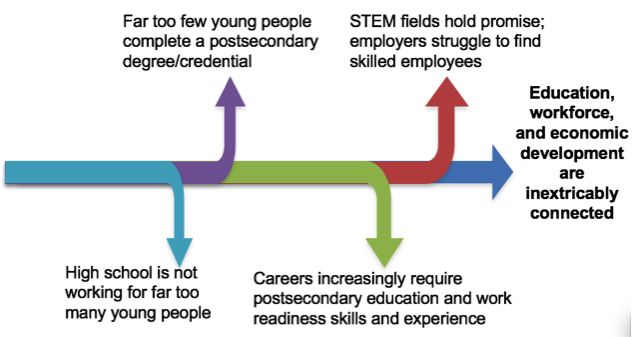
The Network was created in response to HGSE’s report Pathways to Prosperity (Schwartz, Ferguson, & Symonds, 2011), which called for more attention to career and technical education (CTE) and to preparing young people for mid-skill jobs with a strong STEM foundation in fields like health care and information technology. These jobs require education beyond high school but not necessarily a four-year degree. The Network, now in its fifth year, has 14 members, encompassing large and small states, from California and Texas to Delaware; metro areas such as Central Ohio and the Twin Cities; large cities, including New York and Philadelphia; and rural regions such as Northeast Tennessee and California’s Central Valley.
What binds the Network members is a common focus on creating college and career pathways that span grades 9–14 and are designed using a common framework that includes early and sustained career information, exposure, and training. This framework provides a promising approach to reimagining education for our young people. It outlines a place-based learning approach that connects the authentic, contextualized learning of a career academy with an early college approach that leverages academic rigor and student supports to drive equity and accelerate postsecondary credential attainment.
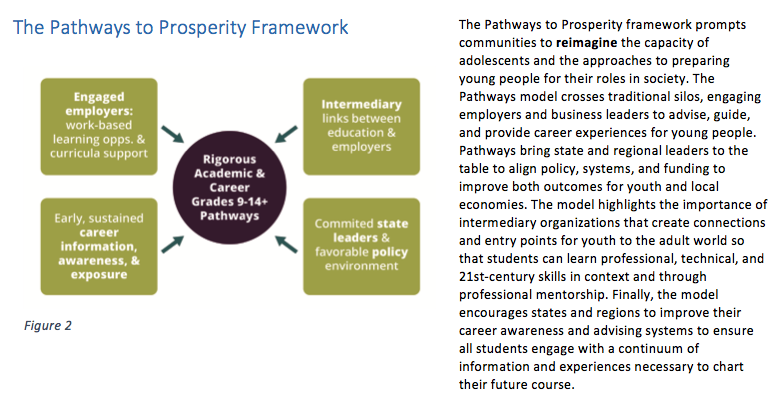
A Developmental Approach: Why Pathways?
Adolescence is a time when young people are developing new cognitive and social capacities. Developmentally, they are primed to seek new experiences and ideas and to explore and question their place in the world. In Youth, Education and the Role of Society (2013), Robert Halpern asserts that “the very types of experiences that young people most need are the hardest to come by in American culture . . . too many young people lack access to the kinds of vital, productive experiences that would enrich their present lives and provide a foundation for adulthood.” His research supports the argument that young people need challenging experiences that allow them to push themselves; they also need to see how adults function in the workplace. Participating in professional, authentic, intergenerational settings helps young people mature. As Sum, Khatiwada, Trubskyy, & Ross noted, “Finding and keeping a job is a key step in a young person’s transition to adulthood and economic self-sufficiency” (2014, p.1).
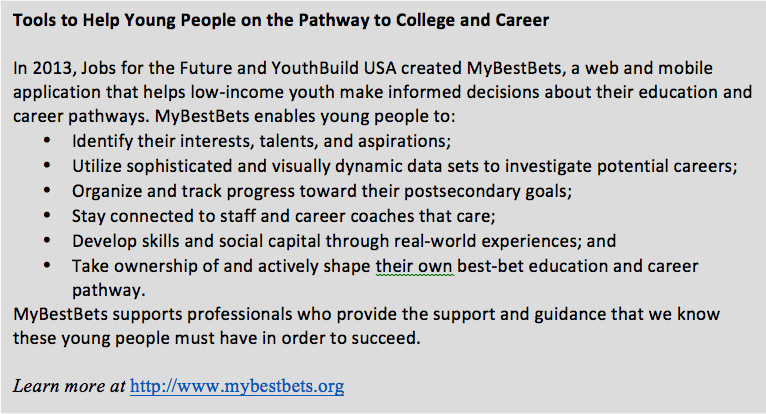
Real-World Education in Service of All Students
The Pathways framework is a systematic approach to improving key outcomes for all young people, not by preparing young people for college then careers but rather by blending education and career-focused learning. In Let’s Get Real: Deeper Learning and the Power of the Workplace (2015), Nancy Hoffman observes, “We tend to assume that young people are supposed to become educated and then go to work . . . Those dichotomies blind us in important ways, however. In fact, work provides powerful opportunities to learn, and the workplace is where many young people are most receptive to applying academic skills and content as well as using critical interpersonal and intrapersonal capacities—i.e., the collection of knowledge and skills referred to as ‘deeper learning.’”
College and career pathways are not a model for “other people’s children.” Rather, important outcomes exist for students from a variety of economic backgrounds. As navigating the terrain between college and career has grown more complex, even university-educated young people face career challenges due to startling gaps between the skills they have acquired through postsecondary education and those sought by their future employers. Career pathways reframe the high school, college, and career experience as an interconnected process shaped by developmental needs. In turn, the challenging and authentic opportunities these pathways provide shape young people’s social and cognitive development and prepare them for roles in their communities.
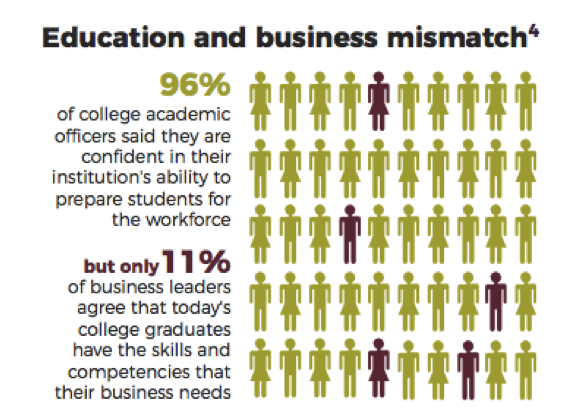
Possible Futures, Possible Selves: Exploring Careers in Middle School
Although Pathways to Prosperity began as a model designed for grades 9–14, two critical patterns emerged in the early days of the Pathways multi-state network. First, asset mapping across member states and regions revealed that career advising and awareness systems were both critically understaffed and under-resourced. Second, Network members expressed the importance of starting career exploration in the middle grades.
Responding to this demand, the Pathways to Prosperity Network launched the Possible Futures, Possible Selves initiative, a developmental approach to support young people in career awareness and exploration, starting in middle school. The work began with career modules focused on three STEM fields: health sciences, information technology, and engineering. Students hone their 21st-century deeper learning skills as they apply design thinking or the engineering design cycle to ideate and iterate solutions to problems contextualized in the world of careers. Through projects, simulations, and career and college visits, middle schoolers become “young professionals.” As they complete challenges based on relevant, real-world problems, they build the foundation for critical thinking, collaboration, and innovation. Whether becoming a young coder and designing apps to solve a community need or supporting a patient’s recovery as an allied health worker, youth experience STEM activities related to the STEM careers that shape our world.
During high school, young people take exploratory classes and receive career guidance that helps them identify their interests and strengths. They select a permeable pathway of study that contextualizes subject knowledge with real-world application, offers a minimum of 12 college credits in both core content and technical programs of study, and provides the opportunity to develop 21st-century skills within the context of a work-based learning internship experience. Secondary and postsecondary curricula and experiences are aligned to labor market opportunities. This seamless vertical alignment provides students with a roadmap to their first college degree and career. Data from years of early college evaluation confirm that this model successfully addresses the many barriers and potholes that throw young people off track; early college models are especially effective in supporting success for students of color and first-generation college goers (Berger, Turk-Bicakci, Garet, Knudson, & Hoshen, 2014).
Exploring STEM Possibilities and Identities
Possible Futures seeks to close the aspiration gap that affects too many young people. Youth who lack exposure to college and career options can struggle to envision a future filled with career and postsecondary opportunities. These youth need engaging opportunities to learn about diverse careers, discover their interests, and develop the skills, knowledge, and attitudes that will lead them to complete college and choose satisfying professional paths. Middle school is a time when young people disconnect from and foreclose on STEM identities, so rich, engaging opportunities to maintain and deepen STEM connections, both in school and beyond, are particularly important.
For some youth, exploring the world of college and careers holds an additional complexity—they may discover environments where they feel they may or may not belong. This especially impacts young women and underrepresented students interested in many STEM fields. Through Possible Futures, students not only see diverse images of STEM professionals but also explore how they could make powerful contributions to their communities. While this approach does not mitigate gaps in STEM representation, it does begin to change the narrative of who belongs in STEM fields and how STEM can be used in service of diverse communities.
In Ready, Willing and Able (2012), Mandy Savitz-Romer and Suzanne M. Bouffard highlight the importance of young people having the ability to envision and believe. “Youth who hold positive beliefs about their abilities and their future options are more likely to feel empowered to take the necessary steps to realize their postsecondary dreams,” the authors observe. Possible Futures resources enable students to learn about career opportunities by exploring activities meant to inspire, engage, and build their STEM capacities—expanding their visions for the future and their belief in their personal competencies (see Figure 4).
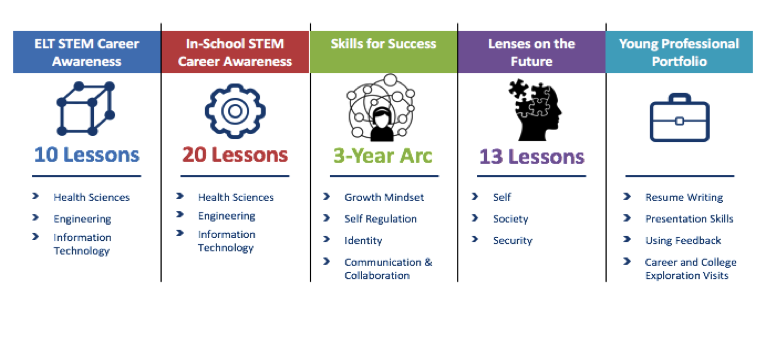
Figure 4 The Possible Futures, Possible Selves Approach
Lessons from the Field
Possible Futures is currently being piloted in over 27 middle schools across three districts in Long Beach, California; Marlborough, Massachusetts; and Boston, Massachusetts. During each cycle of feedback, Possible Futures has incorporated changes based on educators’ experiences implementing the curricula. This initiative has resulted in four major changes to improve the work. Each new component addresses a particular need from the field and is supported by emerging research.
Adapt Resources for Extended Learning Time
The pilot studies have demonstrated a need for multiple learning environments, including out-of-school-time (OST). While some districts with Pathways models were able to allot space within the school day, other school leaders interested in career exploration could not find time within their master schedules. Through a partnership with Citizen Schools, Possible Futures adapted career exploration modules for extended day learning and piloted them in afterschool and summer programs. As shown throughout this compendium, the use of OST can support social and academic gains for all students. OST learning helps to close the opportunity gap related to access to quality STEM programing after school hours. Possible Futures now offers low-cost resources to support the development of powerful OST programs.
Provide the Skills Needed for Success
The gap between skills cultivated in academic settings and those in demand by employers was echoed in Pathways interviews with business leaders across the nation. By teaching what employers call 21st-century skills and offering opportunities for application, the Skills for Success modules support young people in developing capacity in communication, collaboration, self-regulation, and growth mindset. Based on the Foundations for Young Adult Success report (Nagaoka, Farrington, Ehrlich, & Heath, 2015), Possible Futures has developed student-facing modules and professional development for educators to integrate these important skills into academic instruction.
Help Students Understand Opportunities: Lenses on the Future
Schools across the Pathways Network highlighted the uneven abilities of counselors and families to expose students to modern career options, particularly in STEM and technical fields. Given the wide array of available careers in today’s rapidly changing labor market, it is nearly impossible for even the most highly informed and proactive educators and parents to familiarize themselves with the full range of career options available to young people. Since access to guidance about future choices is limited for many young people, developing students’ personal agency and reasoned decision-making abilities is critical. Youth are often left to navigate complex choices with incomplete information or without a robust network of support. The Lenses on the Future module offers a framework of three lenses for youth to view their current options and navigate future opportunities: self, society, and security. These lenses also support families and educators as they offer informal guidance to students.
Engage and Empower Families
Students receive a significant amount of guidance from their families, many of whom may not be familiar with the current opportunities available—and preparation needed—in STEM fields. Possible Futures is piloting school-to-home connections––opportunities that provide information to and invite contributions from families as young people explore their current values and future options.
Conclusion
The career pathways movement and the Possible Futures, Possible Selves initiative encourages us to reimagine education through a developmental lens and reevaluate the notion that education occurs before—and separate from—careers. The framework embraces a balanced systematic approach to education and career experiences that helps young people acquire not only valuable knowledge but also practical skills that stimulate competency, contribution, and engagement. When aligned to opportunities in STEM fields and the labor market, this approach shows potential to improve both outcomes for youth and for our communities, which need their promise and talent.
Learn more at https://ptopnetwork.jff.org/possible-futures
Unless otherwise noted,the images in this article were created by Sheila Jackson, Senior Program Manager at Jobs for the Future.
References
Berger, A., Turk-Bicakci, L., Garet, M., Knudson, J., & Hoshen, G. (2014). Early college, continued success: Early college high school initiative impact study. Washington, DC: American Institutes for Research.
Halpern, R. (2013). Youth, education, and the role of society: Rethinking learning in the high school years. Cambridge, MA: Harvard Education Press.
Hoffman, N. (2015). Let’s get real: Deeper learning and the power of the workplace. Deeper Learning Research Series. Retrieved from http://www.jff.org/sites/default/files/publications/materials/Lets-Get-Real-021715.pdf
Lumina Foundation. (2014). Gallup for Inside Higher Ed Poll.
Nagaoka, J., Farrington, C. A., Ehrlich, S. B., & Heath, R. D. (2015). Foundations for young adult success: A developmental framework. Chicago, IL: University of Chicago.
Savitz-Romer, M., & Bouffard, S. M. (2012). Ready, willing, and able: A developmental approach to college access and success. Cambridge, MA: Harvard Education Press.
Sum, A., Khatiwada, I., Trubskyy, M., & Ross, M. (2014). The plummeting labor market fortunes of teens and young adults. Washington, DC: The Brookings Institution.
Schwartz, R. B., Ferguson, R., & Symonds, W. C. (2011). Pathways to prosperity: Meeting the challenge of preparing young Americans for the 21st century. Retrieved from http://www.gse.harvard.edu/sites/default/files/documents/Pathways_to_Prosperity_Feb2011-1.pdf
Tobie Baker-Wright, Senior Program Manager, Pathways to Prosperity Network
Share

